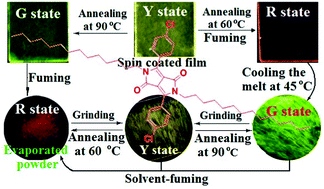Unusual mechanohypsochromic luminescence and unique bidirectional thermofluorochromism of long-alkylated simple DPP dyes†
Abstract
There have been hundreds of organic and metallorganic compounds found to exhibit mechanobathochromic luminescence within tens of nanometers. This paper presents the first example of unusual mechanohypsochromic luminescence and unique bidirectional thermofluorochromism based on 1,4-diketo-2,5-di(tetradecyl)-3,6-bis-(p-chlorophenyl)pyrrolo[3,4-c]pyrrole (TDPP). Pristine TDPP powder is a red emitting crystal (645 nm, R state) and can be changed into a yellow amorphous state (544 nm, Y state) by mechanical grinding or solution spin-coating. The Y state could revert to the R state upon annealing below 60 °C or solvent fuming, however, annealing the Y state above 70 °C produced a new green-emitting crystalline state (523 nm, G state). Furthermore, the G state can transform to the Y and R states upon grinding and solvent fuming, respectively. In contrast, those novel phenomena were not observed in the butylated DPP, demonstrating that the peripheral alkyl chain lengths of organic fluorophores can play diverse functional roles in determining the solid-state aggregation behavior and fluorescence properties. This work has improved some types of stimuli responsive materials and new optical properties of alkylated DPPs have been developed.



 Please wait while we load your content...
Please wait while we load your content...